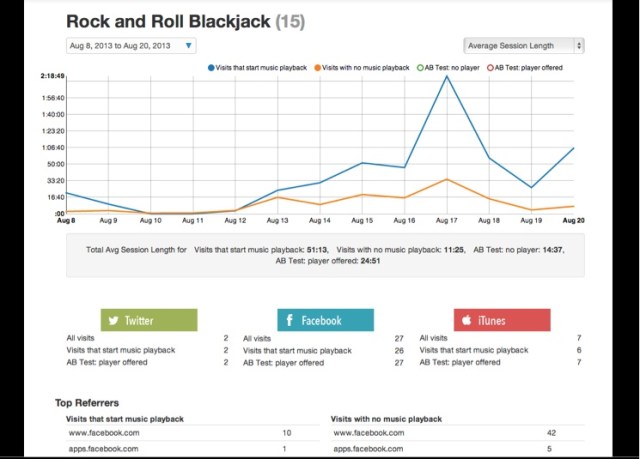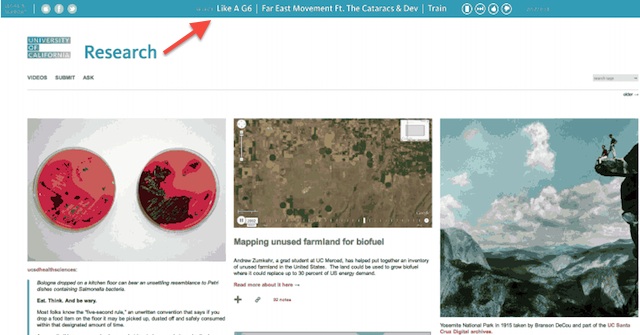Feed.fm just launched at Disrupt SF as part of the Startup Battlefield — and if the service takes off, you may soon be hearing a lot more music on your favorite websites and apps.
Co-founder and CEO Jeff Yasuda is already familiar with the music business. He launched music services Fuzz.com and Blip.fm (which both had some struggles), and he continues to operate both sites under the umbrella of a new company, Feed Media. But as the name suggests, Yasuda expects Feed.fm to become the main business.
When I met with him last week, Yasuda alternately described Feed.fm as “music as a service” and as “Stripe for music.” The goal, he said, is to take all the complication out of music licensing. Normally, if a website owner or an app developer wanted to use licensed music, they’d have to find a lawyer, try to understand SoundExchange, manage the payments, and more. Now, they can just pay Feed.fm a monthly fee and add the service’s stations to their site or app. They can also build stations from their own personal collections. And Feed.fm offers an analytics dashboard and A/B testing so publishers can quantify that the music is improving engagement and see how their visitors are engaging with the music.
Behind the scenes, Feed.fm handles all the complicated details, paying the standard, government-mandated fees for Internet radio. (Yasuda said he’s also trying to develop direct relationships with record labels, though it’s not necessary from a legal perspective.) The service starts at $25 a month, with pricing going up based on the number of tracks played.
Yasuda added that Feed.fm can also integrate with other platforms — and in fact, it’s already live with Shopify customers and and has launched a WordPress plugin.
But do people really want to hear music everywhere online? I was a little skeptical since I’m the kind of person who browses the web with my computer on mute, and Yasuda himself acknowledged that people sometimes turn off the music when they play games. The problem, he suggested, is that the music often isn’t very good. By tapping into Feed.fm’s library of nearly 1 million tracks (plus, as I mentioned, any music in their personal collections), that’s less likely to be a problem.
Music, Yasuda said, is a great way to make users feel more engaged. In fact, he suggested that Feed.fm is one of the few ways that publishers can improve engagement by just paying a small fee. Otherwise, he said, “You can buy an audience with advertising and you can buy retention to some extent with retargeting, but you cannot buy engagement.”
He had some data to back this up, saying that in early tests, websites integrating Feed.fm saw average time spent on site increase by 20 percent to 400 percent, and some saw spending go up by as much as 20 percent.
Sites that are already using Feed.fm include the University of California’s research Tumblr, Foreign Cinema, Frampton’s Guitar Circus, and Fuzz BlackJack.
Not that music will make sense on every site. He suggested that it will work best when there’s a clear, targeted audience, allowing the publisher to pick or build stations that are right for that audience. A broader e-commerce site would have a harder time with that.
Feed Media has raised $1.2 million in funding led by Allegro Venture Partners, with participation from Core Venture Partners, CrunchFund (which, like TechCrunch, was founded by Michael Arrington), Cornice Ventures, Operators Fund, Streamlined Ventures, and individual angel investors.
Feed.fm is offering free trials for a limited time to users who use the code CAPNCRUNCH.
Question & Answer With Judges
Can you share more details about your pricing and how you avoid the struggles of other music startups?
“Most importantly, we focus on customers that are actually making money.”
I like the analytics. Is that what’s going to differentiate you, or is it the ease of use, or is it the collection of music?
“Our customers drive this.” Many customers asked for more details about how people interact with the content, what songs are being shared or skipped, what songs are playing when sales happen, and more.
I’m skeptical that people want a noisy web and this seems like the equivalent of Muzak in stores — but the metrics are impressive. How would someone actually convince visitors to turn the music on?
Some companies blog about it. With other companies, the music is “ingrained in what they are” and “seep into the look of the product” — they don’t have to promote it aggressively because it’s “part of the DNA.”
Can this turn into a giant Play button on the site?
Some brands want a big radio that sits in the middle of the site, others are more subtle.
What kind of music should an early stage venture capital firm play on their site?
[laughs] Classical.



